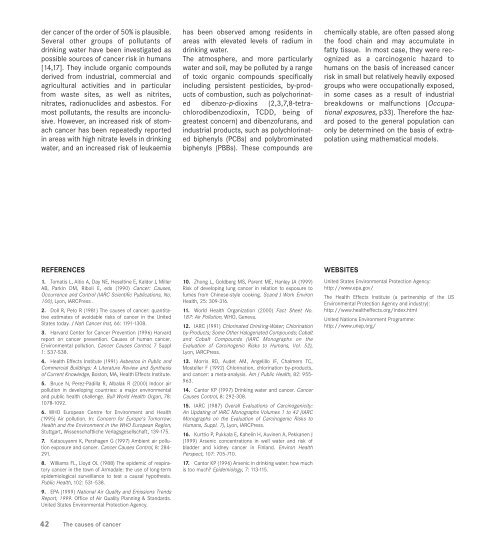world cancer report - iarc
world cancer report - iarc
world cancer report - iarc
You also want an ePaper? Increase the reach of your titles
YUMPU automatically turns print PDFs into web optimized ePapers that Google loves.
der <strong>cancer</strong> of the order of 50% is plausible.<br />
Several other groups of pollutants of<br />
drinking water have been investigated as<br />
possible sources of <strong>cancer</strong> risk in humans<br />
[14,17]. They include organic compounds<br />
derived from industrial, commercial and<br />
agricultural activities and in particular<br />
from waste sites, as well as nitrites,<br />
nitrates, radionuclides and asbestos. For<br />
most pollutants, the results are inconclusive.<br />
However, an increased risk of stomach<br />
<strong>cancer</strong> has been repeatedly <strong>report</strong>ed<br />
in areas with high nitrate levels in drinking<br />
water, and an increased risk of leukaemia<br />
REFERENCES<br />
1. Tomatis L, Aitio A, Day NE, Heseltine E, Kaldor J, Miller<br />
AB, Parkin DM, Riboli E, eds (1990) Cancer: Causes,<br />
Occurrence and Control (IARC Scientific Publications, No.<br />
100), Lyon, IARCPress .<br />
2. Doll R, Peto R (1981) The causes of <strong>cancer</strong>: quantitative<br />
estimates of avoidable risks of <strong>cancer</strong> in the United<br />
States today. J Natl Cancer Inst, 66: 1191-1308.<br />
3. Harvard Center for Cancer Prevention (1996) Harvard<br />
<strong>report</strong> on <strong>cancer</strong> prevention. Causes of human <strong>cancer</strong>.<br />
Environmental pollution. Cancer Causes Control, 7 Suppl<br />
1: S37-S38.<br />
4. Health Effects Institute (1991) Asbestos in Public and<br />
Commercial Buildings: A Literature Review and Synthesis<br />
of Current Knowledge, Boston, MA, Health Effects Institute.<br />
5. Bruce N, Perez-Padilla R, Albalak R (2000) Indoor air<br />
pollution in developing countries: a major environmental<br />
and public health challenge. Bull World Health Organ, 78:<br />
1078-1092.<br />
6. WHO European Centre for Environment and Health<br />
(1995) Air pollution. In: Concern for Europe's Tomorrow:<br />
Health and the Environment in the WHO European Region,<br />
Stuttgart, Wissenschaftliche Verlagsgesellschaft, 139-175.<br />
7. Katsouyanni K, Pershagen G (1997) Ambient air pollution<br />
exposure and <strong>cancer</strong>. Cancer Causes Control, 8: 284-<br />
291.<br />
8. Williams FL, Lloyd OL (1988) The epidemic of respiratory<br />
<strong>cancer</strong> in the town of Armadale: the use of long-term<br />
epidemiological surveillance to test a causal hypothesis.<br />
Public Health, 102: 531-538.<br />
9. EPA (1999) National Air Quality and Emissions Trends<br />
Report, 1999. Office of Air Quality Planning & Standards.<br />
United States Environmental Protection Agency.<br />
42 The causes of <strong>cancer</strong><br />
has been observed among residents in<br />
areas with elevated levels of radium in<br />
drinking water.<br />
The atmosphere, and more particularly<br />
water and soil, may be polluted by a range<br />
of toxic organic compounds specifically<br />
including persistent pesticides, by-products<br />
of combustion, such as polychorinated<br />
dibenzo-p-dioxins (2,3,7,8-tetrachlorodibenzodioxin,<br />
TCDD, being of<br />
greatest concern) and dibenzofurans, and<br />
industrial products, such as polychlorinated<br />
biphenyls (PCBs) and polybrominated<br />
biphenyls (PBBs). These compounds are<br />
10. Zhong L, Goldberg MS, Parent ME, Hanley JA (1999)<br />
Risk of developing lung <strong>cancer</strong> in relation to exposure to<br />
fumes from Chinese-style cooking. Scand J Work Environ<br />
Health, 25: 309-316.<br />
11. World Health Organization (2000) Fact Sheet No.<br />
187: Air Pollution, WHO, Geneva.<br />
12. IARC (1991) Chlorinated Drinking-Water; Chlorination<br />
by-Products; Some Other Halogenated Compounds; Cobalt<br />
and Cobalt Compounds (IARC Monographs on the<br />
Evaluation of Carcinogenic Risks to Humans, Vol. 52),<br />
Lyon, IARCPress.<br />
13. Morris RD, Audet AM, Angelillo IF, Chalmers TC,<br />
Mosteller F (1992) Chlorination, chlorination by-products,<br />
and <strong>cancer</strong>: a meta-analysis. Am J Public Health, 82: 955-<br />
963.<br />
14. Cantor KP (1997) Drinking water and <strong>cancer</strong>. Cancer<br />
Causes Control, 8: 292-308.<br />
15. IARC (1987) Overall Evaluations of Carcinogenicity:<br />
An Updating of IARC Monographs Volumes 1 to 42 (IARC<br />
Monographs on the Evaluation of Carcinogenic Risks to<br />
Humans, Suppl. 7), Lyon, IARCPress.<br />
16. Kurttio P, Pukkala E, Kahelin H, Auvinen A, Pekkanen J<br />
(1999) Arsenic concentrations in well water and risk of<br />
bladder and kidney <strong>cancer</strong> in Finland. Environ Health<br />
Perspect, 107: 705-710.<br />
17. Cantor KP (1996) Arsenic in drinking water: how much<br />
is too much? Epidemiology, 7: 113-115.<br />
chemically stable, are often passed along<br />
the food chain and may accumulate in<br />
fatty tissue. In most case, they were recognized<br />
as a carcinogenic hazard to<br />
humans on the basis of increased <strong>cancer</strong><br />
risk in small but relatively heavily exposed<br />
groups who were occupationally exposed,<br />
in some cases as a result of industrial<br />
breakdowns or malfunctions (Occupational<br />
exposures, p33). Therefore the hazard<br />
posed to the general population can<br />
only be determined on the basis of extrapolation<br />
using mathematical models.<br />
WEBSITES<br />
United States Environmental Protection Agency:<br />
http://www.epa.gov/<br />
The Health Effects Institute (a partnership of the US<br />
Environmental Protection Agency and industry):<br />
http://www.healtheffects.org/index.html<br />
United Nations Environment Programme:<br />
http://www.unep.org/

















